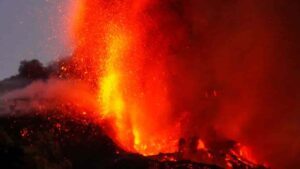
Cornell University researchers have unearthed precise, microscopic clues to where magma is stored, offering a way to better assess the risk of volcanic eruptions.
In recent years, scientists have used satellite imagery, earthquake data and GPS to search for ground deformation near active volcanoes, but those techniques can be inaccurate in locating the depth of magma storage.
By finding microscopic, carbon dioxide-rich fluids encased in cooled volcanic crystals, scientists can accurately determine — within one hundred meters — where magma is located.
“A fundamental question is where magma is stored in Earth’s crust and mantle,” said Esteban Gazel, professor of engineering and lead author of the study, published in Science Advances. “That location matters because you can gauge the risk of an eruption by pinpointing the specific location of magma, instead of other signals like hydrothermal system of a volcano.”
Gazel notes that speed and precision are essential. “We’re demonstrating the enormous potential of this improved technique in terms of its rapidity and unprecedented accuracy,” he said. “We can produce data within days of the samples arriving from a site, which provides better, near real-time results.”
In volcanic events, magma reaches the Earth’s surface, and it erupts as lava and — depending on how much gas it contains — could be explosive in nature. When deposited as part of the fallout of the eruption, fragmented fine-grained material — called tephra — can be collected and evaluated.
Gazel and doctoral student Kyle Dayton deduced how to use inclusions of carbon dioxide-rich fluids trapped within olivine crystals to precisely indicate depth, as the carbon dioxide density of these inclusions is controlled by pressure.
These fluids can be measured quickly using an instrument to determine — in terms of kilometers — how far down the magma was stored and the depth of the scorching reservoir.
Gazel and Dayton joined a small, elite team of international researchers to study the Cumbre Vieja volcano on La Palma in the Canary Islands. Gazel and Dayton picked through tephra to find crystals, which in turn provide data to improve eruption models and forecasts.
Reference:
Kyle Dayton, Esteban Gazel, Penny Wieser, Valentin R. Troll, Juan Carlos Carracedo, Hector La Madrid, Diana C. Roman, Jamison Ward, Meritxell Aulinas, Harri Geiger, Frances M. Deegan, Guillem Gisbert, Francisco J. Perez-Torrado. Deep magma storage during the 2021 La Palma eruption. Science Advances, 2023; 9 (6) DOI: 10.1126/sciadv.ade7641
Note: The above post is reprinted from materials provided by Cornell University. Original written by Blaine Friedlander, courtesy of the Cornell Chronicle.










